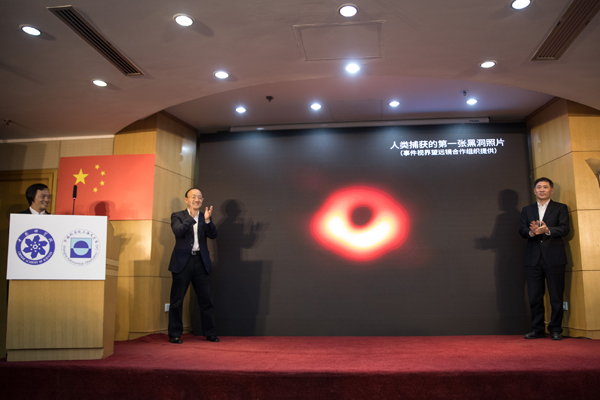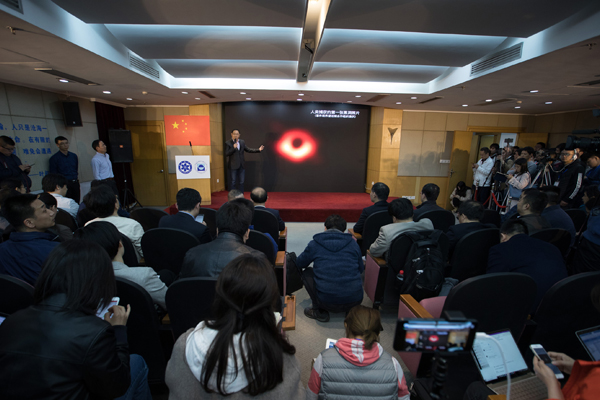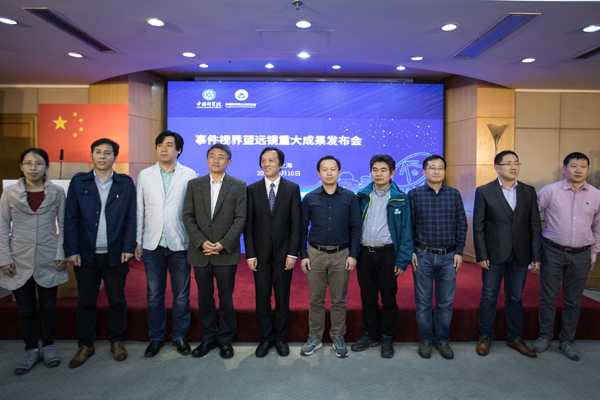First Image of Black Hole Made with China’s Support

The first-ever image of a supermassive black hole at the heart of the distant galaxy M87 is released during a news conference held by Shanghai Astronomical Observatory (SAO), in East China's Shanghai, April 10, 2019. The image of the black hole, based on observations through the Event Horizon Telescope (EHT), a planet-scale array of eight ground-based radio telescopes forged through international collaboration, was unveiled in coordinated press conferences across the globe at around 9:00 pm (Beijing time) on April 10. The landmark result offers scientists a new way to study the most extreme objects in the universe predicted by Albert Einstein's general relativity.[Photo/Xinhua]
The first-ever image of a black hole, a joint effort of more than 200 astronomers worldwide, including 16 from the Chinese mainland, was released on April 10.
It was the first visible representation of what are considered the most extreme objects in the universe.
The image depicts the black hole at the heart of Messier 87, a massive, distant galaxy in the Virgo galaxy cluster. It resides 55 million light-years from Earth and has a mass 6.5 billion times that of the sun.
It puts to the test Albert Einstein's Theory of General Relativity put forward in 1915, which allows for a prediction of the size and shape of a black hole.
The Event Horizon Telescope, a globe-spanning array of eight ground-based radio telescopes, was used to observe the black hole.
It took an international scientific team to capture the paradigm-shifting image, which was announced through coordinated news conferences around the world.
The telescope array used a technique called very-long-baseline interferometry, which synchronized the radio telescopes.
The telescopes are located at high altitudes, including dormant volcanoes in Hawaii in the United States and in Mexico, mountains in Arizona and Spain, a desert in Chile, and Antarctica.
The technique uses Earth's rotation to form one huge, planet-size virtual telescope looking into space at a wavelength of 1.3 millimeters, considered an observation of unprecedented sensitivity and resolution, according to EHT officials.
"Such high resolution is clear enough for someone in a cafe in Paris to read the newspaper held in another person's hand in New York City, or for us to read the number of a credit card on the moon from Earth," said Shen Zhiqiang, head of the Chinese Academy of Sciences' Shanghai Astronomical Observatory and a member of the EHT international team.
Six papers about the research, which offered scientists a new way to study black holes, were published by US-based The Astrophysical Journal Letters on Wednesday.
Scientists explained that black holes are extraordinary cosmic objects with an enormous mass but extremely compact size. The presence of such objects affects their environment in extreme ways, warping the interwoven continuum of space and time and superheating any surrounding material.
"If immersed in a bright region, like a disc of glowing gas, we expect a black hole to create a dark region similar to a shadow-something predicted by Einstein's general relativity that we've never seen before," said Heino Falcke, chair of the EHTScience Council and a professor at Radboud University in Nijmegen, Netherlands.
"This shadow, caused by the gravitational bending and capture of light by the event horizon, reveals a lot about the nature of these fascinating objects and allowed us to measure the enormous mass of M87's black hole." An event horizon is the point where a black hole's gravitational pull cannot be resisted.
Multiple calibration and imaging methods revealed evidence of a ringlike structure with a dark central region-the black hole's shadow-which persisted over multiple independent EHT observations, scientists said.
Shen said that the observations were conducted in April 2017, and it took the international team two years to compare and analyze data to obtain a completely convincing and irrefutable image.
Chinese scientists were involved in the observation through a telescope in Hawaii. They were also highly involved in follow-up data processing and theoretical analysis, he said.
Shanghai and Taipei were selected as two of the cities to hold news conferences, together with Washington, Brussels, Santiago and Tokyo, a recognition of China's contribution.
"In the fields of astronomy, radio astronomy, and space astrophysics, China has made a significant contribution to this global project," Falcke said.
Lu Rusen, a researcher at the Shanghai Astronomical Observatory and another Chinese member of the EHT international team, said that the international group has plans for observations of black holes and other objects in the universe with an even higher resolution.

Shen Zhiqiang, head of Shanghai Astronomical Observatory (SAO), presents related research results during a news conference held in SAO in East China's Shanghai, April 10, 2019. [Photo/Xinhua]

A Chinese astronomer answers questions raised by journalists during a news conference held in Shanghai Astronomical Observatory (SAO), in East China's Shanghai, April 10, 2019. [Photo/Xinhua]

Chinese researchers discuss the imaging methods of the image of a black hole in Shanghai Astronomical Observatory (SAO), in East China's Shanghai, April 9, 2019. [Photo/Xinhua]

Some Chinese astronomers who have made contributions to a global effort to capture the first-ever image of a supermassive black hole at the heart of the distant galaxy M87, pose for a group photo during a news conference held in Shanghai Astronomical Observatory (SAO), in East China's Shanghai, April 10, 2019. [Photo/Xinhua]

Some Chinese astronomers who have made contributions to a global effort to capture the first-ever image of a supermassive black hole at the heart of the distant galaxy M87, pose for a group photo during a news conference held in Shanghai Astronomical Observatory (SAO), in East China's Shanghai, April 10, 2019.[Photo/Xinhua]

Chinese researchers discuss the imaging methods of the image of a black hole in Shanghai Astronomical Observatory (SAO), in East China's Shanghai, April 9, 2019.[Photo/Xinhua]

Chinese researchers Lu Rusen (R) and Huang Lei discuss the imaging methods of the image of a black hole in Shanghai Astronomical Observatory (SAO), in East China's Shanghai, April 9, 2019. [Photo/Xinhua]



